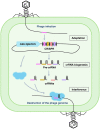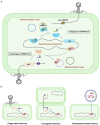Harnessing the CRISPR-Cas Systems to Combat Antimicrobial Resistance
- PMID: 34489905
- PMCID: PMC8418092
- DOI: 10.3389/fmicb.2021.716064
Harnessing the CRISPR-Cas Systems to Combat Antimicrobial Resistance
Abstract
The emergence of antimicrobial-resistant (AMR) bacteria has become one of the most serious threats to global health, necessitating the development of novel antimicrobial strategies. CRISPR (clustered regularly interspaced short palindromic repeats)-Cas (CRISPR-associated) system, known as a bacterial adaptive immune system, can be repurposed to selectively target and destruct bacterial genomes other than invasive genetic elements. Thus, the CRISPR-Cas system offers an attractive option for the development of the next-generation antimicrobials to combat infectious diseases especially those caused by AMR pathogens. However, the application of CRISPR-Cas antimicrobials remains at a very preliminary stage and numerous obstacles await to be solved. In this mini-review, we summarize the development of using type I, type II, and type VI CRISPR-Cas antimicrobials to eradicate AMR pathogens and plasmids in the past a few years. We also discuss the most common challenges in applying CRISPR-Cas antimicrobials and potential solutions to overcome them.
Keywords: CRISPR-Cas system; antimicrobial resistance; genome targeting; phage delivery; plasmid curing.
Copyright © 2021 Duan, Cao, Zhang and Xu.
Figures


Similar articles
-
Delivery of CRISPR-Cas systems using phage-based vectors.Curr Opin Biotechnol. 2021 Apr;68:174-180. doi: 10.1016/j.copbio.2020.11.012. Epub 2020 Dec 23. Curr Opin Biotechnol. 2021. PMID: 33360715 Review.
-
Reinvigorating AMR resilience: leveraging CRISPR-Cas technology potentials to combat the 2024 WHO bacterial priority pathogens for enhanced global health security-a systematic review.Trop Med Health. 2025 Apr 2;53(1):43. doi: 10.1186/s41182-025-00728-2. Trop Med Health. 2025. PMID: 40176174 Free PMC article. Review.
-
Survey of clustered regularly interspaced short palindromic repeats and their associated Cas proteins (CRISPR/Cas) systems in multiple sequenced strains of Klebsiella pneumoniae.BMC Res Notes. 2015 Aug 4;8:332. doi: 10.1186/s13104-015-1285-7. BMC Res Notes. 2015. PMID: 26238567 Free PMC article.
-
Repurposing prokaryotic clustered regularly interspaced short palindromic repeats-Cas adaptive immune system to combat antimicrobial resistance.Future Microbiol. 2023 May;18:443-459. doi: 10.2217/fmb-2022-0222. Epub 2023 Jun 15. Future Microbiol. 2023. PMID: 37317864 Review.
-
The Application of the CRISPR-Cas System in Antibiotic Resistance.Infect Drug Resist. 2022 Aug 2;15:4155-4168. doi: 10.2147/IDR.S370869. eCollection 2022. Infect Drug Resist. 2022. PMID: 35942309 Free PMC article. Review.
Cited by
-
An insights into emerging trends to control the threats of antimicrobial resistance (AMR): an address to public health risks.Arch Microbiol. 2024 Jan 22;206(2):72. doi: 10.1007/s00203-023-03800-9. Arch Microbiol. 2024. PMID: 38252323 Review.
-
Save the microbes to save the planet. A call to action of the International Union of the Microbiological Societies (IUMS).One Health Outlook. 2023 Mar 6;5(1):5. doi: 10.1186/s42522-023-00077-2. One Health Outlook. 2023. PMID: 36872345 Free PMC article.
-
Origin of Antibiotics and Antibiotic Resistance, and Their Impacts on Drug Development: A Narrative Review.Pharmaceuticals (Basel). 2023 Nov 15;16(11):1615. doi: 10.3390/ph16111615. Pharmaceuticals (Basel). 2023. PMID: 38004480 Free PMC article. Review.
-
Antibiotic resistance and preventive strategies in foodborne pathogenic bacteria: a comprehensive review.Food Sci Biotechnol. 2025 Jan 29;34(10):2101-2129. doi: 10.1007/s10068-024-01767-x. eCollection 2025 Jun. Food Sci Biotechnol. 2025. PMID: 40351726 Free PMC article. Review.
-
Recent advances in gene-editing approaches for tackling antibiotic resistance threats: a review.Front Cell Infect Microbiol. 2024 Jun 26;14:1410115. doi: 10.3389/fcimb.2024.1410115. eCollection 2024. Front Cell Infect Microbiol. 2024. PMID: 38994001 Free PMC article. Review.
References
Publication types
LinkOut - more resources
Full Text Sources
Miscellaneous

